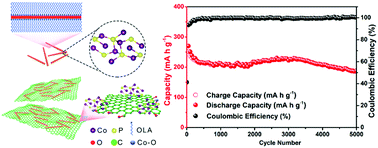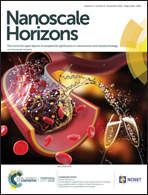Ultrafine Co2P nanorods wrapped by graphene enable a long cycle life performance for a hybrid potassium-ion capacitor†
Abstract
Given their high theoretical capacities, metal phosphides are anticipated to be excellent charge-storage materials for high-efficiency potassium-ion batteries. However, one of the major problems is the shuttling of heavy and large K+ ions between electrodes, which triggers rapid capacity fading. Here, we demonstrate that sub-4 nm Co2P nanorods attached to reduced graphene oxide (Co2P@rGO) can operate at a lifespan exceeding thousands of cycles. By taking advantage of the high electronic conductivity and flexibility of reduced graphene oxide (rGO), the composite electrode delivers a high capacity (374 mA h g−1 at 20 mA g−1) and excellent C-rate capability (141 mA h g−1 at 2 A g−1), superior to its commercial counterpart. Impressively, the electrode maintains 54% of the capacity over 5000 cycles, and there is almost no capacity fading after the initial 200 cycles. In addition, a hybrid potassium-ion capacitor, assembled from a Co2P@rGO anode and activated carbon cathode, affords a high energy/power density (87 W h kg−1 and 4260 W kg−1) in a potential window of 1.0–4.0 V, as well as a long lifespan of over 1000 cycles. These extremes demonstrate the high-performance of the Co2P@rGO anode materials and an optimal synthesis strategy to boost K+ storage performance.

- This article is part of the themed collections: Nanoscale Horizons Most Popular Articles and Horizons Community Board Collection – Advanced Energy Storage Technologies


 Please wait while we load your content...
Please wait while we load your content...